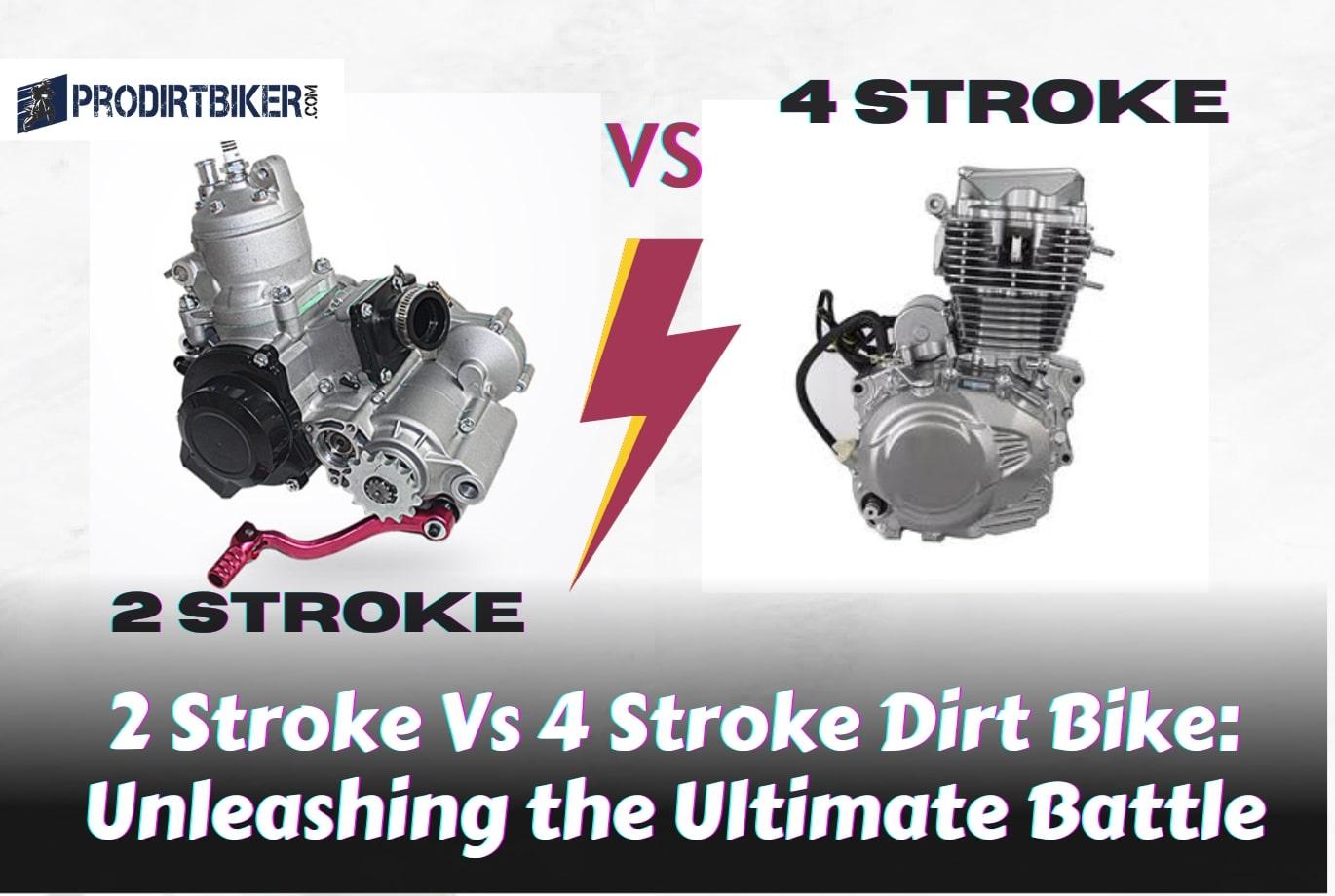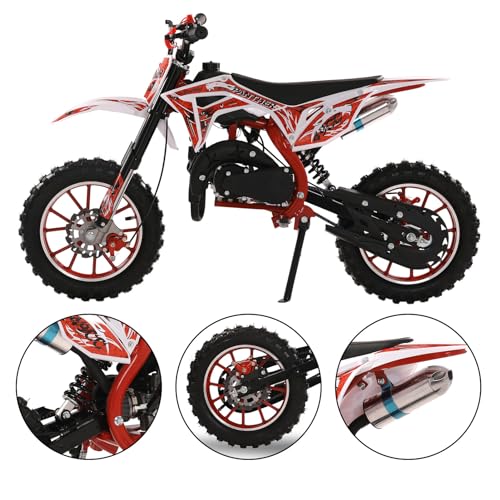2 Stroke Vs 4 Stroke Dirt Bike: Unleashing the Ultimate Battle

Are you torn between choosing a 2 stroke or 4 stroke dirt bike? Don’t worry; you’re not alone. Many riders find themselves grappling with this decision, as both options have their own unique advantages and disadvantages.
In this blog post, we’ll break down the differences between 2 stroke vs 4 stroke dirt bikes and help you determine which one is the best fit for your riding style and preferences. So, whether you’re a seasoned rider looking to upgrade your bike or a newbie trying to decide which type to start with, read on for some valuable insights that will help you make an informed choice.
2 Stroke Vs 4 Stroke Dirt Bike Which is Better?
A 2-stroke dirt bike and a 4-stroke dirt bike differ in their engine design, with the former having a simpler and lighter design compared to the latter. The choice between the two comes down to personal preference and riding style.
The choice between a 2-stroke and a 4-stroke dirt bike depends on your specific riding preferences, skill level, and intended use. Neither type is definitively better than the other; it’s more about which one aligns with your needs and riding style. Here are some considerations for each:
2-Stroke Dirt Bike:
- Pros:
- Lighter Weight: 2-stroke dirt bikes are generally lighter due to their simpler design, which can make them more agile and easier to handle, especially in motocross and racing situations.
- Responsive Power: They deliver immediate and responsive throttle response, making them favored by riders who appreciate quick acceleration and sharp power delivery.
- Simplicity: 2-strokes have fewer moving parts, resulting in easier and less time-consuming maintenance.
- Cons:
- Less Torque: Typically, 2-strokes have less low-end torque, which might require more aggressive riding and gear changes to maintain power.
- Fuel Efficiency: They tend to be less fuel-efficient, meaning you may need to refuel more frequently.
- Emissions: 2-strokes generally emit higher levels of pollutants and are considered less environmentally friendly.
4-Stroke Dirt Bike:
- Pros:
- Smoother Power: 4-strokes offer a smoother and more linear power delivery, which can be advantageous for trail riding and endurance.
- More Torque: They often have more torque at lower RPMs, making them easier to ride and providing better traction on technical terrain.
- Fuel Efficiency: 4-strokes are typically more fuel-efficient, allowing for longer rides between refueling.
- Cons:
- Heavier: Due to their more complex design, 4-strokes are generally heavier, which can make them less nimble in certain riding scenarios.
- Maintenance: They require more complex maintenance, including valve adjustments, which can be intimidating for beginners.
- Initial Cost: 4-stroke dirt bikes usually come with a higher initial purchase price.
Ultimately, the choice depends on your riding goals and style. If you prioritize quick acceleration, agility, and are comfortable with more frequent maintenance, a 2-stroke may be the better option. If you prefer a smoother power delivery, more torque, and lower maintenance demands, a 4-stroke may be a better fit.
It’s also a good idea to test ride both types if possible and consider factors like local regulations and emissions standards, as these may influence your decision. Additionally, consulting with experienced riders or seeking advice from a reputable dirt bike dealer can help you make an informed choice based on your individual needs and preferences.

A Comparison Table On 2 Stroke Vs 4 Stroke Dirt Bike:
Certainly, here’s a comparison table highlighting the main differences between 2-stroke and 4-stroke dirt bikes:
Certainly, here’s a comparison table highlighting the main differences between 2-stroke and 4-stroke dirt bikes:
| Aspect | 2-Stroke Dirt Bike | 4-Stroke Dirt Bike |
|---|---|---|
| Engine Cycle | Two-stroke (intake, compression, power, exhaust) | Four-stroke (intake, compression, power, exhaust) |
| Fuel Delivery | Mix of oil and gasoline (pre-mixed or oil-injected) | Gasoline only (separate oil reservoir) |
| Power Delivery | More immediate and responsive throttle response | Smoother and more linear power delivery |
| Torque and Low-End Power | Typically less torque at lower RPMs | Generally more torque at lower RPMs |
| Maintenance | Easier and less time-consuming maintenance | More complex maintenance, including valve adjustments |
| Fuel Efficiency | Typically less fuel-efficient | Generally more fuel-efficient |
| Emissions | Typically higher emissions and less environmentally friendly | Lower emissions and more environmentally friendly |
| Noise Level | Often louder due to higher RPMs | Quieter operation |
| Weight | Generally lighter due to simpler design | Typically heavier due to additional components |
| Longevity | Shorter overall engine life | Longer overall engine life |
| Price | Often more affordable upfront | Generally higher initial cost |
| Riding Style | Preferred by some for motocross and racing | Preferred by some for trail riding and endurance |
| Skill Level | Can be more challenging to ride due to powerband | Easier for beginners and less experienced riders |
| Availability | May have limited availability in certain regions | Widespread availability |
It’s important to note that the choice between a 2-stroke and a 4-stroke dirt bike often depends on personal preferences, riding style, and intended use. Riders should consider their skill level, the type of terrain they plan to ride on, and their maintenance capabilities when selecting the most suitable option. Additionally, local regulations and emissions standards may influence the availability and choice of dirt bike types in certain areas.
Understanding The Battle: 2 Stroke Vs 4 Stroke
The battle between 2 stroke and 4 stroke dirt bikes has long been a topic of debate among off-road enthusiasts. These two types of engines offer distinct advantages and disadvantages, making it crucial to understand their key differences. Whether you’re a seasoned rider or a beginner looking to venture into the world of dirt bikes, this comparison will shed light on which type is better suited to your needs.
Key Differences Between 2 Stroke And 4 Stroke Dirt Bikes:
- Power delivery: 2 stroke engines generate power with every revolution of the crankshaft, resulting in a more instant and responsive acceleration. On the other hand, 4 stroke engines offer a smoother and more consistent power delivery, often with more torque at lower rpms.
- Maintenance: 2 stroke engines are generally simpler and easier to work on due to their fewer moving parts. They require less maintenance, making them a popular choice for racers who demand regular adjustments. In contrast, 4 stroke engines tend to be more complex and may require additional maintenance due to oil changes, valve adjustments, and other routine tasks.
- Fuel efficiency: 4 stroke engines are more fuel-efficient compared to their 2 stroke counterparts. Their combustion process is designed to use fuel more effectively, resulting in longer rides between refueling. This can be a significant advantage for riders who embark on long-distance adventures or prefer extended trail rides.
- Weight distribution: 2 stroke engines are typically lighter, which can contribute to improved maneuverability and agility on the trails. Their compact size also allows for a more centralized weight distribution, enhancing the bike’s handling capabilities. Conversely, 4 stroke engines tend to be heavier, affecting the bike’s overall balance, but may provide better stability in certain riding conditions.
- Environmental impact: Due to their design, 4 stroke engines produce lower emissions compared to 2 stroke engines. This makes them more environmentally friendly and compliant with stricter emission regulations. 2 stroke engines, while known for their power, tend to burn oil along with the fuel mixture, resulting in higher emissions and pollution.
Understanding the differences between 2 stroke and 4 stroke dirt bikes is essential for riders looking to make an informed decision. Whether you prioritize power, maintenance, fuel efficiency, weight distribution, or environmental impact, each type has its own set of advantages and disadvantages.
Consider your riding style, terrain, and personal preferences to determine which engine configuration suits your needs best. So, before you start your off-road escapades, ensure you choose the right engine for an exhilarating and satisfying ride.
Unleashing The Power Of 2 Stroke Dirt Bikes
When it comes to off-road biking, the debate between 2 stroke and 4 stroke dirt bikes has been ongoing for years. While 4 stroke bikes are known for their torque and efficiency, 2 stroke bikes offer a thrilling and power-packed riding experience that enthusiasts cannot resist.
If you’re someone who craves pure adrenaline and wants to unleash the true power of a dirt bike, then a 2 stroke might just be the perfect choice for you.
Advantages Of 2 Stroke Dirt Bikes
Higher power-to-weight ratio:
- 2 stroke dirt bikes are renowned for their impressive power-to-weight ratio. The lightweight design combined with a high-performance engine allows these bikes to accelerate at lightning-fast speeds.
- With less weight to carry around, 2 stroke dirt bikes can effortlessly conquer steep hills and traverse through challenging terrain with ease. It’s no wonder why they are a favorite among motocross riders who value speed and agility.
Instant power delivery:
- One of the biggest advantages of 2 stroke dirt bikes is their instant power delivery. The unique combustion process of a 2 stroke engine ensures that power is available right from the moment you twist the throttle.
- Unlike their 4 stroke counterparts that require time to build up power, 2 stroke dirt bikes deliver a sudden burst of energy that can take you by surprise. This instantaneous power makes these bikes a thrilling choice for riders who enjoy the adrenaline rush of rapid acceleration.
Enhanced maneuverability:
- Another notable advantage of 2 stroke dirt bikes is their enhanced maneuverability. The lightweight construction and nimble handling of these bikes allow riders to easily maneuver through tight corners, navigate tricky trails, and perform gravity-defying stunts.
- Whether you’re racing around a motocross track or exploring off-road trails, the agility of a 2 stroke dirt bike allows you to effortlessly change direction, giving you the upper hand when it comes to maneuvering through challenging terrain.
- Additionally, the responsive throttle response of 2 stroke engines enables riders to quickly adjust their speed, making it easier to take on jumps, navigate obstacles, and maintain control in tight spots.
If you’re looking for a dirt bike that provides an unrivaled power-to-weight ratio, instant power delivery, and enhanced maneuverability, then the 2 stroke is the ultimate choice. Embrace the thrill and discover the true power unleashed by a 2 stroke dirt bike.
So gear up, hold on tight, and get ready for an exhilarating ride like no other.

The Role Of Technology In 2 Stroke Power
Breakthrough advancements in 2 stroke engine technology:
- 2 stroke engines have undergone significant advancements in technology, enhancing their power and performance capabilities.
- Improved design and construction methods have resulted in more efficient combustion, leading to increased power output.
- Lightweight materials and compact designs have made 2 stroke engines popular in dirt bikes, providing a high power-to-weight ratio.
- These advancements have made 2 stroke engines a top choice for riders who seek a thrilling and agile riding experience.
Fuel injection systems for optimal performance:
- The introduction of fuel injection systems in 2 stroke engines has revolutionized their performance.
- Fuel injection allows for precise control of the fuel-air mixture, optimizing combustion efficiency and reducing emissions.
- This technology eliminates the need for carburetors, resulting in smoother power delivery and improved throttle response.
- Riders can now enjoy consistent performance across different riding conditions, such as varying altitudes and temperatures.
Power valve systems for improved power delivery:
- Power valve systems play a crucial role in enhancing power delivery in 2 stroke engines.
- These systems adjust the exhaust port timing based on engine rpm, optimizing the torque and power output.
- At low rpms, the power valve restricts the exhaust port, promoting more low-end torque for better traction.
- As rpms increase, the power valve gradually opens, allowing for increased airflow and power in the higher rpm range.
- This technology provides riders with a broader powerband, making it easier to navigate through different terrains and obstacles.
The role of technology in 2 stroke power has significantly transformed the performance and capabilities of these engines. Breakthrough advancements in engine design, along with the introduction of fuel injection systems and power valve technology, have greatly improved power delivery, efficiency, and overall performance.
Dirt bike riders can now enjoy a thrilling and exhilarating experience with 2 stroke engines that combine lightweight construction and unmatched power.
Exploring The Limitations Of 2 Stroke Dirt Bikes
If you are a dirt bike enthusiast, you may have found yourself debating between a 2 stroke and a 4 stroke dirt bike. While both options have their advantages, it’s important to explore the limitations of 2 stroke dirt bikes before making a decision.
In this section, we will discuss the emissions concerns and implications, limited torque at lower rpm, higher maintenance requirements, and fuel efficiency challenges associated with 2 stroke dirt bikes.
Emissions Concerns And Implications
- Two stroke dirt bikes have long been criticized for their higher emissions compared to four stroke dirt bikes.
- Due to the combustion process in 2 stroke engines, they tend to produce higher levels of carbon monoxide, hydrocarbons, and particulate matter.
- These emissions can have environmental impacts and may not comply with stricter emission regulations in certain areas.
Limited Torque At Lower Rpm
- One of the limitations of 2 stroke dirt bikes is their limited torque at lower rpm (revolutions per minute).
- The power delivery in 2 stroke engines is different from their 4 stroke counterparts, as they rely on a simpler design.
- At lower rpms, 2 stroke engines may lack the pulling power needed for smoother acceleration and climbing steep inclines.
Higher Maintenance Requirements
- Another aspect to consider when opting for a 2 stroke dirt bike is the higher maintenance requirements.
- Due to their simpler design and the mixture of oil and fuel, 2 stroke engines require more frequent maintenance.
- Components such as spark plugs, air filters, and exhausts may need more regular attention and replacements.
Fuel Efficiency Challenges
- Fuel efficiency can also pose a challenge when it comes to 2 stroke dirt bikes.
- The design of these engines requires them to consume a greater amount of fuel compared to their 4 stroke counterparts.
- This means that riders may need to carry more fuel for longer rides, increasing the weight and affecting the overall performance.
While 2 stroke dirt bikes have their advantages in terms of simplicity and power delivery, it’s essential to consider their limitations. Emissions concerns and implications, limited torque at lower rpm, higher maintenance requirements, and fuel efficiency challenges should be thoroughly understood before making a decision.
By weighing these factors against your riding preferences and environmental considerations, you’ll be able to make a more informed choice when selecting a dirt bike that best suits your needs.
The Dominance Of 4 Stroke Dirt Bikes
When it comes to choosing between a 2 stroke and 4 stroke dirt bike, the dominance of the 4 stroke option is hard to ignore. These bikes have gained immense popularity in recent years, thanks to their impressive performance and advanced features.
In this section, we will explore the advantages of 4 stroke dirt bikes, highlighting why they are the preferred choice for many riders.
Advantages Of 4 Stroke Dirt Bikes
One of the key advantages of 4 stroke dirt bikes is their broad powerband, which offers a versatile riding experience. Here’s why this feature makes a significant difference:
- Better power distribution: Unlike 2 stroke bikes that rely on power pulses, 4 stroke engines provide a consistent power delivery throughout the rpm range. This means you can enjoy smooth acceleration and control at any speed.
- Enhanced control: The broad powerband allows riders to easily adjust their speed and power output, making it suitable for various terrains. Whether you’re tackling steep hills or maneuvering tight corners, a 4 stroke dirt bike provides the control you need.
Improved low-end torque is another key advantage of 4 stroke dirt bikes. Here’s how it benefits your riding experience:
- Better traction: With increased low-end torque, 4 stroke bikes excel at generating power at lower engine speeds. This translates to better traction, particularly when dealing with tricky off-road conditions or when starting from a standstill. You can navigate challenging terrains with confidence, knowing your bike has the torque to conquer them.
- Smoother power delivery: The low-end torque of a 4 stroke engine ensures a smoother and more predictable power delivery, reducing the chances of wheel spin and improving overall ride quality. This is especially beneficial when you need precise throttle control, such as in tight corners or rough trails.
In addition to the above benefits, 4 stroke dirt bikes offer superior fuel efficiency and longer riding ranges. Here’s why this matters:
- Fuel efficiency: 4 stroke engines are known for their excellent fuel economy. With advancements in technology, modern 4 stroke dirt bikes have become even more efficient, allowing you to ride longer without the need for frequent refueling. This not only saves you money on gas but also extends your riding adventures.
- Longer riding range: Thanks to their fuel efficiency, 4 stroke dirt bikes can travel longer distances on a single tank of fuel. This is especially crucial for riders undertaking endurance races, long trail rides, or exploring remote areas where fuel stations are scarce. The longer riding range gives you the freedom to push boundaries and explore without worrying about running out of fuel.
In a nutshell, 4 stroke dirt bikes offer a range of advantages that make them an appealing choice for riders of all skill levels. From their broad powerband for versatile riding to improved low-end torque for better traction and superior fuel efficiency for longer riding range, these bikes are designed to dominate the dirt.
So, if you’re seeking a thrilling off-road experience with enhanced control and performance, a 4 stroke dirt bike should be at the top of your list.
The Evolution Of 4 Stroke Technology
Valvetrain Advancements For Enhanced Performance
- Over the years, 4 stroke dirt bikes have undergone significant advancements in their valvetrain technology, leading to enhanced performance and power delivery.
- Valvetrains are responsible for controlling the airflow in and out of the engine cylinder, ensuring efficient combustion.
- The introduction of overhead camshafts (ohc) in 4 stroke engines has allowed for better valve control, resulting in improved power and responsiveness.
- Equipped with multiple valves, these modern valvetrains enable a larger intake and exhaust area, allowing the engine to breathe more efficiently.
- The use of rocker arms and camshafts with variable lift technology helps optimize valve timing and lift, further enhancing the overall performance of 4 stroke dirt bikes.
Variable Valve Timing For Optimized Power Delivery
- Variable valve timing (vvt) is a technology that has revolutionized the performance capabilities of 4 stroke dirt bikes.
- With vvt, the engine can adjust the timing of the intake and exhaust valves according to the engine’s rpm and load conditions.
- At low rpms, vvt delays the opening and closing of the valves, optimizing torque and improving low-end power delivery.
- As the engine speeds up, vvt advances the valve timing, maximizing airflow and power output in the mid to high rpm range.
- This dynamic valve timing system ensures that the engine performs at its best across the entire rpm range, providing riders with an optimized power delivery at all times.
Electronic Fuel Injection For Precise Fuel Control
- One of the significant advancements in 4 stroke technology is the introduction of electronic fuel injection (efi).
- Efi systems have replaced traditional carburetors, offering precise fuel control and improved fuel efficiency.
- The efi system uses sensors to monitor various engine parameters, such as throttle position, air temperature, and engine speed.
- This data is then processed by the engine control unit (ecu), which determines the exact amount of fuel to be injected into the combustion chamber.
- By delivering the right amount of fuel at the right time, efi ensures optimal combustion, resulting in improved performance, smoother throttle response, and reduced emissions.
With advancements in valvetrain technology, the introduction of variable valve timing, and the implementation of electronic fuel injection, 4 stroke dirt bikes have come a long way in terms of performance and efficiency. These technological advancements have helped shape the modern-day dirt bike engines, offering riders enhanced power delivery, improved throttle response, and better fuel economy.
Whether you’re a recreational rider or a professional racer, these advancements in 4 stroke technology have undoubtedly taken dirt biking to a whole new level.
Examining The Drawbacks Of 4 Stroke Dirt Bikes
Dirt biking is an exhilarating sport that requires adrenaline-pumping rides and tight maneuverability. While 4 stroke dirt bikes have their own advantages, it is important to understand their drawbacks as well. In this section, we will examine the key drawbacks of 4 stroke dirt bikes, including their heavier weight, complex engine design, and slower power build-up compared to their 2 stroke counterparts.
Heavier Weight Affecting Maneuverability
One of the main drawbacks of 4 stroke dirt bikes is their heavier weight, which can impact maneuverability on challenging terrains. Here are some key points to consider:
- The added weight of a 4 stroke engine can make it more difficult to handle and maneuver the bike, especially in tight turns and jumps.
- The bulkier construction of 4 stroke dirt bikes can make them less agile compared to their lighter 2 stroke counterparts.
- Riders may find it challenging to navigate through tight trails and corners due to the increased weight, affecting their overall riding experience.
Complex Engine Design Leading To Higher Maintenance Costs
Another drawback of 4 stroke dirt bikes is their complex engine design, which can result in higher maintenance costs. Consider the following:
- The sophisticated design of the 4 stroke engine requires more intricate components and maintenance procedures, resulting in increased expenses.
- Regular maintenance tasks such as valve adjustments and oil changes can be more time-consuming and expensive compared to the simpler maintenance of 2 stroke dirt bikes.
- Many riders may find it daunting to perform routine maintenance on their 4 stroke bikes, necessitating professional help that can add up in cost.
Slower Power Build-Up Compared To 2 Stroke Counterparts
When it comes to pure power and speed, 4 stroke dirt bikes generally have a slower power build-up compared to their 2 stroke counterparts. Consider the following points:
- The combustion cycle of a 4 stroke engine is longer compared to a 2 stroke engine, resulting in a slower power delivery.
- While 4 stroke engines typically have more low-end torque, they may lack the immediate burst of power that 2 stroke engines are known for, which can be advantageous in certain riding situations.
- Riders who prefer the faster acceleration and responsiveness of 2 stroke dirt bikes may find 4 stroke bikes less thrilling in terms of power delivery.
Although 4 stroke dirt bikes offer certain advantages, they also come with their fair share of drawbacks. Being heavier, requiring more maintenance, and having a slower power build-up compared to 2 stroke counterparts may impact a rider’s overall experience. It’s important to weigh these drawbacks against the benefits before making a decision on which type of dirt bike is best suited for your riding style and preferences.
Frequently Asked Questions For 2 Stroke Vs 4 Stroke Dirt Bike
What Is The Difference Between A 2 Stroke And 4 Stroke Dirt Bike?
A 2 stroke dirt bike has a simpler design, lighter weight, and higher power-to-weight ratio compared to a 4 stroke dirt bike.
Which Is Faster, A 2 Stroke Or A 4 Stroke Dirt Bike?
In general, 2 stroke dirt bikes are faster due to their lighter weight and higher power output.
Are 2 Stroke Dirt Bikes More Fuel Efficient Than 4 Stroke Dirt Bikes?
No, 4 stroke dirt bikes are typically more fuel efficient as they burn fuel more efficiently and have better overall mileage.
Are 2 Stroke Dirt Bikes Easier To Maintain Than 4 Stroke Dirt Bikes?
Yes, 2 stroke dirt bikes have fewer moving parts and require less complex maintenance compared to 4 stroke dirt bikes.
Which Type Of Dirt Bike Is Better For Beginners, 2 Stroke Or 4 Stroke?
For beginners, 4 stroke dirt bikes are generally recommended as they provide more control and a smoother power delivery, making them easier to handle.
Conclusion
To determine whether a 2-stroke or 4-stroke dirt bike is the right choice for you, it’s important to consider various factors. While 2-stroke bikes offer higher power-to-weight ratio and simpler maintenance, 4-stroke bikes excel in fuel efficiency and durability. Ultimately, your preference and riding style will play a key role in deciding which bike is best suited for your needs.
When it comes to power delivery, 2-stroke bikes provide instant throttle response and are more agile on tight tracks. On the other hand, 4-stroke bikes offer smoother power delivery, making them ideal for trail riding and longer distances. Additionally, 4-stroke engines tend to produce less noise and emissions, aligning them with modern environmental regulations.
Both 2-stroke and 4-stroke dirt bikes have their own advantages and disadvantages. It is crucial to consider factors such as riding style, maintenance requirements, fuel efficiency, and personal preferences when making a decision. By weighing these factors, you can choose a bike that suits your riding needs and ensures an enjoyable and thrilling off-road experience.






